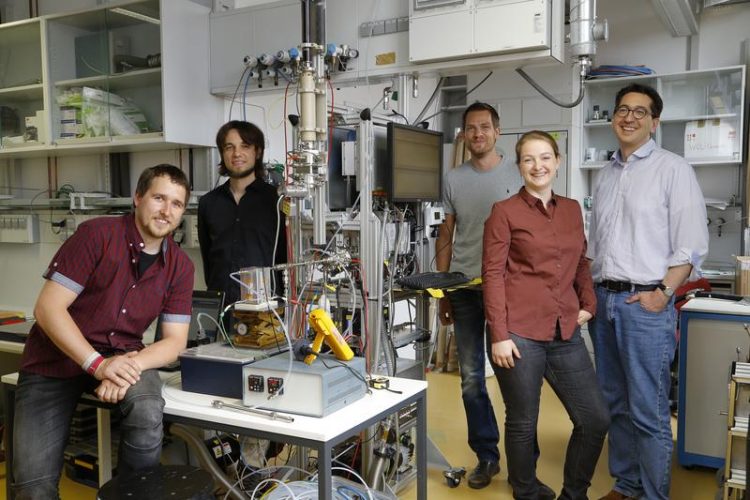Clouds and climate in the pre-industrial age

Mario Simon (from left zu right), Martin Heinritzi, Andreas Kürten, Andrea Wagner und Joachim Curtius mit dem von ihnen entwickelten Massenspektrometer. Uwe Dettmar
“These results are the most important so far by the CLOUD experiment at CERN”, said CLOUD spokesperson Jasper Kirkby, Honorary Professor at the Goethe University. “When the nucleation and growth of pure biogenic aerosol particles is included in climate models, it should sharpen our understanding of the impact of human activities on clouds and climate.”
Professor Joachim Curtius from the Institute for Atmospheric and Environmental Sciences at the Goethe University added: “We believe that the newly discovered process will mean that we will have to reassess cloud formation in earlier times, as there must have been more particles present than we had previously assumed. There would therefore be less of a difference between the situation then and now than previously thought.”
The CLOUD experiment is looking at how new aerosol particles form in the atmosphere and their effect on climate. As the aerosol particles increase, as is the case due to human activities, more sunlight is reflected and more cloud droplets form, making the clouds brighter.
In order to estimate the cooling effect caused by anthropogenic influences, it is necessary to know the quantities of aerosols present in the pre-industrial age. As direct measurement is not an option, the effects are simulated through reliable laboratory tests such as the CLOUD experiment, and then applied to climate modelling.
In pre-industrial times, the organic compounds emitted by trees were a major contributing factor in the formation of aerosols. The researchers examined alpha-pinene, a substance that gives pine forests their characteristic pleasant smell. They are among the most important biogenic emissions. Alpha-pinene is rapidly oxidised on exposure to ozone and the ensuing reaction chains create some extremely low-volatility substances. However, these only occur in very small concentrations of around one molecule per one trillion air molecules.
The CLOUD experiments show that these extremely low-volatility organic compounds are very efficient at forming new particles. This process occurs under atmospheric conditions, even in the absence of sulphuric acid. It had been assumed that sulphuric acid was virtually always involved in particle formation in the atmosphere. The main source of sulphuric acid in the atmosphere is sulphur dioxide, which is generated by the burning of fossil fuels.
Furthermore, the researchers discovered that ions from cosmic rays strongly enhance the production rate of the organic particles – by a factor of 10-100 compared to particle formation without ions, provided the concentrations of the particle-forming gases are low.
“Furthermore, our studies show that these low-volatility organic substances also dominate particle growth in unpolluted environments across the entire size range from clusters of just a few molecules all the way up to sizes of 50-100 nm, where the particles are large enough to be able to seed cloud droplets”, explained Joachim Curtius. The growth rates accelerate as the particles increase in size, because more and more oxidation products, also those of higher volatility, are able to condense on the expanding particles. This process is described in quantitative terms with a condensation model for the various organic substances.
Why is this knowledge important for our understanding of the climate? This may well be a very important mechanism, because it is so efficient in terms of the formation of organic particles under natural conditions. As soon as the particles have formed, they grow through the condensation of other similar oxygenated organic compounds. The rapid growth of the newly-formed particles means that they lose a smaller percentage through collisions with pre-existing large particles. As a result more particles grow to sizes that have the potential to seed clouds and influence the climate.
Another paper that appears in the same issue of “Science” reports on observations from the observatory on the Jungfraujoch, which detected pure organic nucleation in the free troposphere. This proves the relevance of the CLOUD laboratory experiments for the atmosphere.
https://cds.cern.ch/record/2155289
https://cds.cern.ch/record/2154271
Media Contact
All latest news from the category: Earth Sciences
Earth Sciences (also referred to as Geosciences), which deals with basic issues surrounding our planet, plays a vital role in the area of energy and raw materials supply.
Earth Sciences comprises subjects such as geology, geography, geological informatics, paleontology, mineralogy, petrography, crystallography, geophysics, geodesy, glaciology, cartography, photogrammetry, meteorology and seismology, early-warning systems, earthquake research and polar research.
Newest articles

First-of-its-kind study uses remote sensing to monitor plastic debris in rivers and lakes
Remote sensing creates a cost-effective solution to monitoring plastic pollution. A first-of-its-kind study from researchers at the University of Minnesota Twin Cities shows how remote sensing can help monitor and…

Laser-based artificial neuron mimics nerve cell functions at lightning speed
With a processing speed a billion times faster than nature, chip-based laser neuron could help advance AI tasks such as pattern recognition and sequence prediction. Researchers have developed a laser-based…

Optimising the processing of plastic waste
Just one look in the yellow bin reveals a colourful jumble of different types of plastic. However, the purer and more uniform plastic waste is, the easier it is to…



